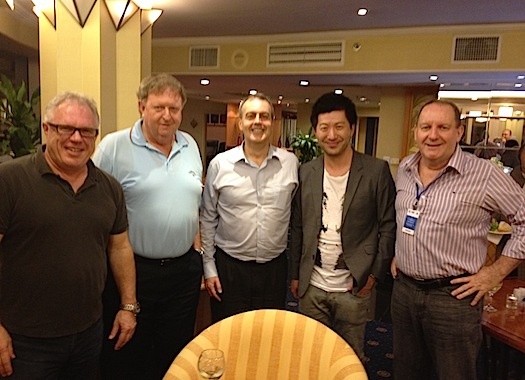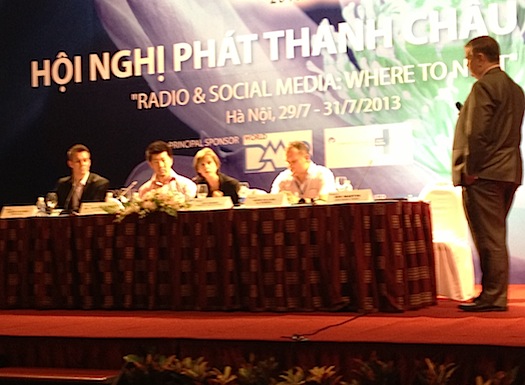How is Vietnamese commune radio different from community radio? How many pirate stations are there in Thailand? What is Indonesia doing about digital radio? Today’s RadioAsia conference report gives a perspective across the ASEAN region.
Thailand
Kritsada Terdpong, a regulator from Thailand outlined the transition taking place in that country from tightly controlled official media to the tentative birth of independent voices through community radio. There were many pirate ‘illegal stations’ in the past, but the country is now in the process of formalising the 1812 former illegal stations which have now got commercial, public or community licences. The first Thailand broadcasting master plan is now being developed for spectrum planning and a new licencing framework.
Digital Radio DAB+ was trialed in Thailand earlier this year with the help of Australian experts. The successful results and digital radio “seems to be the solution to reception problems” in such a crowded radio landscape as Thailand, according to Terdpong.
Indonesia
Woro Indah Widiastuty from Indonesia’s Ministry of Communications, said there is
a high demand for radio licences in Indonesia, but radio advertising expenditure is expected to decline and radio listenership is also declining in the face of new technology such as internet. “Digital radio and mobile media will be important for radio broadcasters to keep their audiences high,” she said.
“There are many technical problems with analog radio so Indonesia needs digital broadcasting. Digital radio broadcasting is a solution to improve the use of channel efficiency in such a crowded market and will also help broadcasters retain audience and be more innovative for advertisers.”
Indonesia conducted digital trials in 2006 and 2007, testing a range of digital transmission types and finally deciding on the DAB family of standards, using the VHF frequency band. The policy is that digital radio will complement, not replace, analog radio at this time.
Vietnam
Doan Quang Hoan spoke about spectrum allocation for radio broadcasting and radio’s role in the Vietnamese society: Radio contributes 18,000 jobs to the economy and money from advertising and promotions. To the society it contributes education, culture and education.
Commune radio in Vietnam is a type of community radio, owned by the communes and played via PA speakers and by low power transmitters. There are over 11,000 commune stations in Vietnam, which announce local events and information from the governing communist party.
TV and phone reach is not very high in Vietnam, so radio continues to be a prime mass medium, with the number of stations increasing. There are more than 5,700 radio stations in Vietnam, including commune radio. FM stations are the most numerous but AM is still the main transmission medium for wide coverage. “But radio is facing major challenges from multi media and strong competitors, so radio will need to move into digital technologies in the future,” said Doan.
Korea
Soon Young Hong from KBC Korea said some people believe the influence of radio is not as strong as it used to be. “So I say, we need to try harder than we used to, to gain influence.” Influence – how to get it? “The answer is through creativity,” he told conference delegates.
Other Perspectives
Also on the agenda were a range of perspectives on key areas radio needs to focus on to remain strong into the future.
“Engaging content must be accessible across many platforms,” said Joan Warner, identifying a range of important areas such as content, celebrity and regulation. “We believe Australian radio has too much regulation compared with the new platforms which we compete with, which have little no regulation at all.”
Mark Collier added the word “innovation” to Joan Warner’s list of important factors that will keep radio relevant in the future. He also mentioned accountability and responsibility. “We have enormous power and clout so we must be accountable and aware of the power we have. We must use that power properly.”
Steve Ahern chaired a panel of speakers on Talk Radio. Talkback is opening up in Vietnam and allowing the voice of the people to be heard by government according to Voice of Vietnam presenter Phon. The session also heard case studies from Australia and the UK, showing the power of talk radio. Key points included: tell stories to engage listeners, use social media to drive audiences back to the radio station, and find a real way to make facts and figures meaningful for listeners.

Some of the Aussies at RadioAsia: Keith Williams, Mark Neely, Steve Ahern, Morten Boyer, Mark Collier.
Lanni Smith, an Australian working for Radio France International, comes from a public service broadcaster background and spoke from that point of view. “Connectivity and technology is not a problem for us as a well resourced broadcaster, but how the audience is changing is the most important thing for us… you have to know your audience, their habits and balance it with what kind of charter you have.”
A question pondered by several speakers was how broadcasters can turn the mobile phone into the next default radio receiving device. Has audio really transferred to mobile? “I’m not sure we’re there yet, but its up to us to market ourselves to get radio into those devices,” said the BBC’s Simon Kendall.
Jason Malaure told delegates it is “a great aim to be on every type of device, but the technical realities of so many devices and standards presents many technological problems for those who create apps. Streaming quality can also be very tricky in a 3G environment… we have to get it right if we want people to listen to radio on mobile phone platforms.”
Community Radio
To be called community radio it should be “in the community, for the community, about the community and by the community,” said Louie Tabing, a community radio leader from the Philippines in a session titled ‘A Voice for the Voiceless.’ His view is that there should be no obstacles for people who want to participate in community radio.
“Community radio uses simple technology and takes production to the community. It supports and promotes the community and promotes citizen engagement with the media. It helps to put people in charge of their affairs.”
Bradley Freeman gave the example of community ‘Taxi Radio’ in Thailand, an illegal community station that was very popular until shut down some time ago. The station was very important during the 2006 coup in disseminating alternative views on what was happening. There are 204 AM stations and 334 FM stations in Thailand, mostly controlled by official organisations, although things are now changing as a new licencing regime takes hold in the country.
Children’s Radio
While radio for children is not a strong genre in Australia, a session on ‘Storytelling and the On Air Imagination’ showed that children’s radio is still important across many countries in the ASEAN region.
The session went from NHK Radio’s presenter urging programmers to return to the simplicity of single narrator storytelling for young children, to the complexity of RTHK’s Sunday Smile program.
Shunji Kudo gave the example of NHK’s radio story time program for pre-schoolers, which nurtures imagination through sound. Other children’s programs on NHK also use the same style, with simple stories encouraging listening in the classroom, followed by discussions where the children tell each other what was in their imagination when they were listening.
Tim Littlechild from RTHK showcased a fast moving, interactive multi media program called Sunday Smile, which engages primary school children through online games, an interactive website and energetic high energy programming. The success of the show is its high production values and the fact that each week a different school class comes to the radio studios to make segments for the program.
Other speakers included Yasser Garrana, who gave tips on what makes good storytelling, such as strong characters and a central premise and Moses Lye examined the case study of MeRadio, an app which engages teenagers by allowing them to create playlists, review music and buy songs, as well as listening to the radio station.

